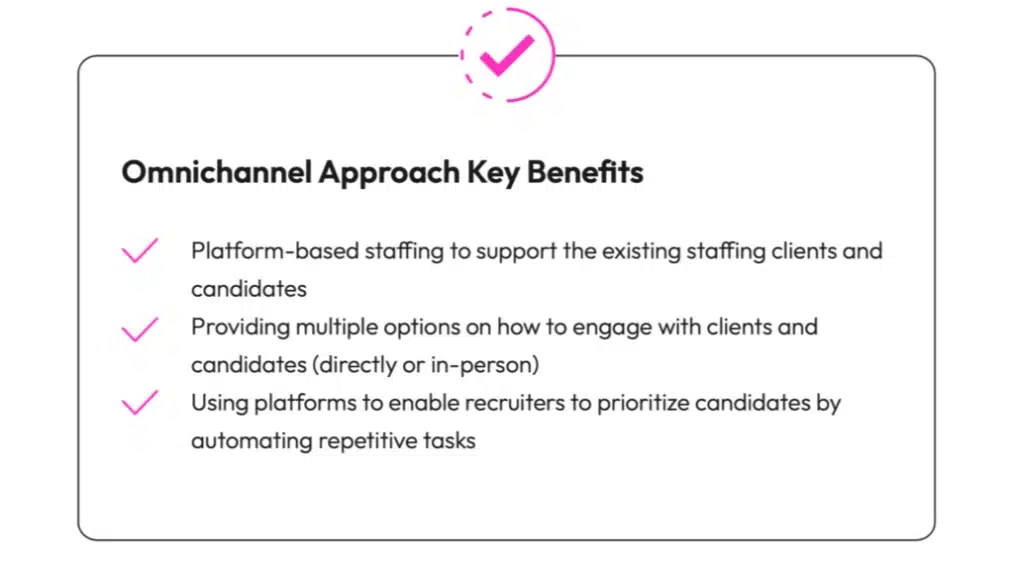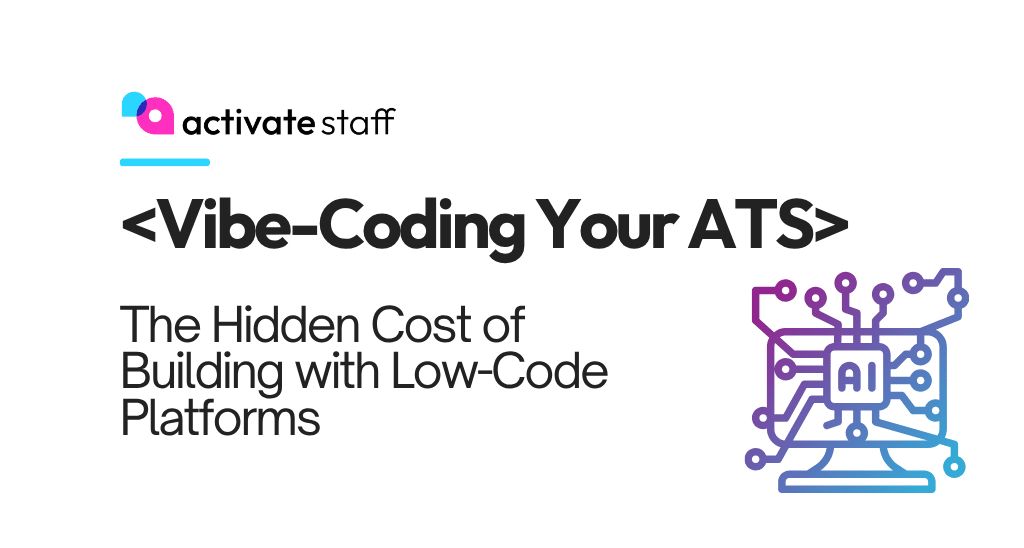In every industry, new technologies pop up to keep up with consumers’ changing demands and needs. In the staffing industry, the applicant tracking system (ATS) or candidate relationship management (CRM) used to be all the buzz. Now there is increased chatter around new terms such as staffing platforms and staffing platforms as a service (SPaaS). But what exactly are these?
This blog is Part 1 of a three-part blog series on staffing platforms. Explore the series below:
Part 2 – Staffing Platforms: A Deep Dive Into Features And Benefits
What is a staffing platform?
A staffing platform or temporary staffing platform are a technology that optimizes the process of filling open job orders primarily by providing a seamless mobile experience for candidates. Often involving the automation of repetitive tasks usually done by the recruiter, it offers self-service options for candidates to input information and complete other manual to-dos.
Candidates can create online profiles, complete onboarding, communicate with recruiters, and search and apply for work themselves by filtering through pre-selected jobs all through the platform. It also simplifies the process for the agency (and in some cases, for the end client) to view and select which job seekers meet the criteria, schedule/place them, and track time and payments. It’s the convergence of staffing and technology created for a better end-to-end candidate experience.
You may also come across the term “temporary staffing platform”, a type of staffing platform specifically used to schedule workers on a shift or short-term basis, typically for on-site work. Related to this, a “talent platform” is often used to arrange work that can be done remotely, typically the professional staffing verticals.
Another particular type of staffing platform is a staffing platform as as service (SPaaS). Similar to software as a service (SaaS), SPaaS is software that an agency purchases from a third-party vendor instead of building their own, acquiring their own, or using a staffing platform with its own talent marketplace. Staffing platforms as a service allow agencies to leverage platform technology to create their own branded talent communities instead of dipping into a third-party marketplace.

How do you distinguish between a true staffing platform vs. a limited app?
At its core, a true staffing platform enables on-demand work and the candidate experience, primarily from a mobile device. In order for something to deliver on the promise of true staffing platform tech, candidates need to be able to find a job as easily as Uber allows them to hail a taxi and as easily as Skip the Dishes allows them to order food.
While many staffing agencies can engage their candidates through a mobile application or website, there is a difference between a limited app and a true staffing platform. A true on-demand staffing platform optimizes the entire placement process and bakes in automation for efficiency gains from the convenience of a mobile device. In short, it is more than the sum of its parts.
A limited app may support certain tasks associated with a traditional staffing approach, such as providing an online job board or scheduling tool. But it does not offer the same seamless end-to-end candidate experience as a true mobile staffing platform that is going to help agencies unlock the potential for true candidate stickiness.
What does this mean for my agency?
According to statistics recently published by Staffing Industry Analysts (SIA), overall interest and implementation of staffing platforms are ramping up. According to their 2021 survey results, 86% of agencies were aware of these staffing platform technologies. Of those, 12% already have a proprietary app/platform or are utilizing a third-party provider. Another 25% plan to build or implement a staffing platform in the next two years.
For those in professional or commercial staffing verticals, digital transformation is imminent and inevitable. Particularly for healthcare staffing agencies, implementing new platforms has led to a remarkable surge of growth – 72% of the recent market growth for platforms has come from healthcare staffing. And it’s no wonder since the efficiency gains have been well proven out in healthcare (for more information you can read our case study featuring CoreMedical Group who has seen a 30%+ revenue increase from their staffing platform).
How are agencies transitioning to new staffing platforms?
While there are some agencies that simply decide to make the jump into platform-based staffing, many staffing firms have opted for an omnichannel approach as a strategy for the smooth adoption of new technology. It’s a blend of traditional and platform-based staffing where agencies can choose to interact with candidates and clients digitally or in person, rather than limiting themselves to one communication channel. This approach allows for the gradual adoption of new technology and processes by:
- Allowing platform-based staffing to support the existing staffing clients and candidates.
- Providing multiple options on how to engage with clients and candidates (directly or in-person).
- Using platforms to enable recruiters to prioritize candidates by automating repetitive tasks.

While it’s difficult to make changes that could upturn the traditional staffing process, ultimately the data shows that it is the market’s direction. One only needs to look toward firms like AYA Healthcare to see the success of a platform-based approach. While their swift adoption was a bold decision, fueled by increased demand during the pandemic, they continue to surpass industry benchmarks 3-4x over, providing their recruiters the ability to manage upwards of 100 nurses at a time through the platform.
Interested in learning more about these trends and how they could benefit your agency? Book a demo with our team today.





